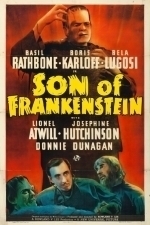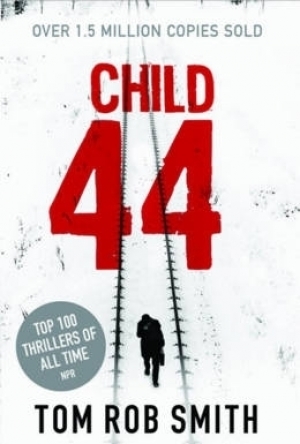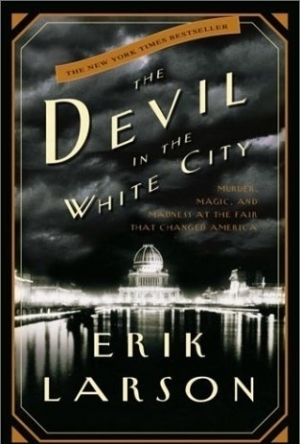Matthew Krueger (10051 KP) rated Son of Frankenstein (1939) in Movies
Oct 9, 2020
The plot: Baron Wolf von Frankenstein (Basil Rathbone) is determined to prove the legitimacy of his father's scientific work, thus rescuing the family name from disgrace. With the help of Ygor (Bela Lugosi), a grave robber, Wolf successfully reanimates the monster (Boris Karloff) his father originally brought back from the dead. But when several villagers are killed mysteriously, Wolf must find the culprit in order to vindicate his creation, or face the possibility that he may be responsible.
Universal's declining horror output was revitalized with the enormously successful Son of Frankenstein, in which the studio cast both stars.
After the ousting of the Laemmles from Universal and the British embargo on American horror films in 1936, Karloff and Lugosi found themselves in a career slump. For two years, horror films were out of favor at Universal Studios. On April 5, 1938, a nearly bankrupt theater in Los Angeles staged a desperate stunt by showing Frankenstein, Dracula and King Kong as a triple feature. The impressive box office results led to similarly successful revivals nationwide. Universal soon decided to make a big-budget Frankenstein sequel.
Son of Frankenstein marks changes in the Monster's character from Bride of Frankenstein. The Monster is duller and no longer speaks, explained by being injured by a lightning strike. The monster also wore a giant fur vest, not seen in the first two Frankenstein films, perhaps to add color to his appearance when the film was planned to be shot in color. He is fond of Ygor and obeys his orders. The Monster shows humanity in three scenes: first when he is disturbed by his image in a mirror, especially when compared to the Baron. Next, when he discovers Ygor's body, letting out a powerful scream, and later when he contemplates killing Peter but changes his mind. While the first two films were clearly set in the 1900s, this film appears to take place in the 1930s, judging by the appearance of a modern automobile.
Peter Lorre was originally cast as Baron Wolf von Frankenstein, but he had to leave the production when he became ill. Replacing Lorre was Basil Rathbone, who had scored a major triumph as Sir Guy of Gisbourne in The Adventures of Robin Hood, released the previous year.
According to the documentary Universal Horror (1998), the film was intended to be shot in color and some Technicolor test footage was filmed, but for artistic or budgetary reasons the plan was abandoned. No color test footage is known to survive, but a clip from a Kodachrome color home movie filmed at the studio and showing Boris Karloff in the green monster makeup, clowning around with makeup artist Jack Pierce, is included in the same documentary.
Its a excellent universal monster film.
Asiza Tait (139 KP) rated Child 44 in Books
Feb 1, 2018
This book takes you through the transformation of Leo Demidov from a complete ‘company man’ of the Russian State to a real person listening to his own sense of right and wrong. We meet him as a no nonsense officer of the MGB willing and able to follow through on his orders and completely committed to succeeding. We also get glimpses of his insecurity because no one is safe under the scrutiny of the State. He is very aware of this and the long running jealousy of Vasily is a constant reminder of how much someone hates him and desperately wishes and works towards his downfall. From the beginning the life of Leo is shown for the stark reality it is. There is no happy family man here, or even a happy career man, it is purely survival in a very structured and dangerous place.
The relationship between Leo and his wife Raisa is another that is deep, raw and completely honest. Their relationship ebbs and flows according to the State plan, but the book takes a serious turn when Leo is faced with the decision of denouncing his wife. Seeing into their marriage is like facing a needed surgery, the inevitable pain is necessary to start the way to healing. Raisa is the stronger character in my view, never losing her sense of humanity but knowing how to hide herself in order to survive.
Leo’s decision starts a chain of events that leads to him discovering that murders are occurring the breadth of Russia, and since there is no crime in Russia he is the only one trying to convince anyone of the scary reality that a serial child killer/s is on the loose. His commitment to this brings further scrutiny on him and he feels the full force of the authorities and experiences a complete reversal of circumstances. Where he was the one arresting people and transporting them to the most notorious prison Lubyanka, he is now the one in the prisoners' seat.
There are twists and turns in this book that will knock the breath out of you. A seriously brilliant book.
On a personal note I found this book hit too close to home in regards to my own upbringing in the Jehovah’s Witnesses. Where Leo is hitting his head against a stone wall in trying to convince people of the danger they are ignoring, it reminded me very strongly of how difficult it is to convince or motivate the Governing Body of Jehovah’s Witnesses and the Congregation Elders that the right thing to do when an accusation of child abuse comes to them is to immediately call the authorities. They instead stick to their own procedures in the face of irrefutable evidence and demonstrated experience that their procedures are dead wrong and need to be changed, they still refuse to listen and insist that their way of doing things is right and everyone else must be wrong. They desperately work to keep their image clean just like the Russian Government insists that the State is always right. Thankfully there is an army of people worldwide working incredibly hard to expose there hurtful practices and in so doing protect the public from being sucked into this so called religion.

Sobotta Anatomy Atlas Free
Medical and Education
App
Download the Sobotta Anatomy App free of charge and test its full functionality with 40 unrestricted...

Heart Pro III
Medical and Education
App
DEVELOPED IN COLLABORATION WITH STANFORD UNIVERSITY SCHOOL OF MEDICINE & IN PARTNERSHIP WITH DR....

Skeleton System Pro III
Medical and Education
App
DEVELOPED IN COLLABORATION WITH STANFORD UNIVERSITY SCHOOL OF MEDICINE. This app is not to be...

Easy Release - Model Release App
Photo & Video and Business
App
► NEW: iCloud-Drive, Sync and Save PDF to Dropbox ◄ ► Multi-Page Releases - New In-App...

Jazza's Arty Games
Art & Design, Entertainment and Games
App
Jazza's ARTY GAMES is a fun tool you can use to accompany your drawing sessions to practice with,...
Hadley (567 KP) rated The Devil in the White City: Murder, Magic, and Madness in Books
Jan 18, 2021
He's been a doctor and a licensed pharmacist, who then conned an old couple into selling their drug store to him where he preyed on young girls and ignorant customers that would buy whatever Holmes would tell them to buy, whether it were real or fake tonics.
He was a building owner who had a murder hotel secretly built with " a wooden chute that would descend from a secret location on the second floor all the way to the basement... ", "a room next to his office fitted with a large walk-in vault, with airtight seams and asbestos-coated iron walls. A gas jet embedded in one wall would be controlled from his closet...", "a large basement with hidden chambers and a sub-basement for the permanent storage of sensitive material. "
He owned and ran an alcohol-treatment company known as the Silver Ash Institute that claimed to have the cure for alcoholism.
He was a traveling business man, who had two wives and two children. He established the Campbell-Yates Manufacturing Company, which made nothing and sold nothing.
He was also labeled as America's first serial killer. His body count is unknown even today; his victims were frequently young women, which included stenographers and house wives. He was best known for convincing people who trusted him to sign him as the beneficiary of their life insurance policies, only to kill them and make it seem an accident so he could collect the money.
Holmes grew up in a small farming village in New Hampshire, where he briefly spoke about an early fear of a human skeleton that hung in a doctor's office: " 'I had daily to pass the office of one village doctor, the door of which was seldom if ever barred,' he wrote in a later memoir. 'Partly from its being associated in my mind as the source of all the nauseous mixtures that had been my childish terror (for this was before the day of children's medicines), and partly because of vague rumors I had heard regarding its contents, this place was one of peculiar abhorrence to me.' "... "Two children discovered Mudgett's [Holmes' real last name] fear and one day captured him and dragged him 'struggling and shrieking' into the doctor's office. 'Nor did they desist,' Mudgett wrote, 'until I had been brought face to face with one of its grinning skeletons, which, with arms outstretched, seemed ready in its turn to seize me. It was a wicked and dangerous thing to do to a child of tender years and health,' he wrote, ' but it proved an heroic method of treatment, destined ultimately to cure me of my fears, and to inculcate in me, first, a strong feeling of curiosity, and, later, a desire to learn, which resulted years afterwards in my adopting medicine as a profession.' "
Erik Larson's fourth book, the Devil in the White City, is only partly about Holmes and his dark trail of murder and lies. The story told is mostly centered around the planning and building of the 1893 World's Fair. The prologue opens with one of the architects aboard a ship long after the fair has ended - - - 1912 to be exact- - - where he begins to write of the fair in his diary. The next chapter continues on with Chicago competing against other major cities to win the rights to host the World's Fair. Chicago was not the ideal place for the fair because it was known for it's crime and slaughter houses - - - this was exactly why the politicians wanted it so badly there, so it would help to lighten the image of Chicago for the rest of the world. Even the local Whitechapel Club that had sprouted up after the infamous murders by Jack the Ripper, were excited to win the rights to host the fair in their city, and celebrated in a macabre way:
"Upon learning that Chicago had won the fair, the men of the Whitechapel Club composed a telegram to Chauncey Depew, who more than any other man symbolized New York and its campaign to win the fair. Previously Depew had promised the members of the Whitechapel Club that if Chicago prevailed he would present himself at the club's next meeting, to be hacked apart by the Ripper himself - - - metaphorically, he presumed, although at the Whitechapel Club could one ever be certain? The club's coffin, for example, had once been used to transport the body of a member who had committed suicide. After claiming his body, the club hauled it to the Indiana Dunes on Lake Michigan, where members erected an immense pyre. They placed the body on top, then set it alight. Carrying torches and wearing black hooded robes, they circled the fire singing hymns to the dead between sips of whiskey. The club also had a custom of sending robed members to kidnap visiting celebrities and steal them away in a black coach with covered windows, all without saying a word.
The club's telegram reached Depew in Washington twenty minutes after the final ballot, just as Chicago's congressional delegation began celebrating at the Willard Hotel near the White House. The telegram asked, 'When may we see you at our dissecting table?' "
There are chapters in-between, technically reading like a side story, that tell us about Holmes and his misdeeds in Chicago, but there just wasn't enough about Holmes that I could consider this a True Crime book, nor an informative book about Holmes. Unfortunately, when the reader begins to really dwell into the story of Holmes, it's quickly ended by having two or more chapters about the building of the World's Fair. One interesting point about the story is that the reader does get to see how many inventions were brought to light because of the Fair, such as the invention of the Ferris Wheel. Larson's writing is very coherent and the descriptions are so well done that the reader is practically transported back to the late 1800s, yet, before I finished the book, I felt misled by the title... then coming across everything that happened to not only the Fair, but the people who were involved with it, it's hard not to wonder if the whole thing was cursed, thus the Devil being in the White City.
One of the side stories I did really enjoy was the slow unfolding of a man named Prendergast. A delusional young man who ran one of the groups of paperboys in Chicago, who was also obsessed with politics, became a determined supporter of Mayor Harrison; after Harrison was voted into office again, Prendergast believed it was because of him and the letters he sent out to numerous politicians and potential voters. Prendergast also believed he deserved a chair on the council for Harrison's re-election, for which he even showed up at City Hall to take over. This incident was the straw that broke the camel's back for Prendergast - - - he was humiliated when the people there laughed in his face. Prendergast then decided to take matters into his own hands, and bought a revolver. The day before the Fair would end, Prendergast showed up at Harrison's home and shot him. Harrison died minutes later. Prendergast turned himself in for the murder as soon as he left Harrison's residence. When asked why he had done it, Prendergast responded: " ' Because he betrayed my confidence. I supported him through his campaign and he promised to appoint me corporation counsel. He didn't live up to his word.' "
This book has been voted as a top True Crime must-read novel. I don't agree with this. As I said before: Holmes' chapters are few; eighty percent of this book is about the building of the World's Fair. As a True Crime junkie, I didn't enjoy this one, but also as a history junkie, I enjoyed learning about the Fair and everything that happened. I can't recommend this book to TC fans or horror fans. It's mostly history and architecture.
Sophia (Bookwyrming Thoughts) (530 KP) rated The Shadowglass (The Bone Witch, #3) in Books
Jan 23, 2020
<h2><strong>My body, heart and soul were not ready for the final book.</strong></h2>
I procrastinated reading <em>The Shadow Glass</em> because this is the end. The End. THE END.
<img class="aligncenter size-full wp-image-2925" src="https://bookwyrmingthoughts.com/wp-content/uploads/sites/317/2017/06/internal-screaming-sherlock.gif"; alt="internal screaming sherlock" width="320" height="147" />
It's a week after finishing the last book in <em>The Bone Witch</em> trilogy and mere hours before this review is going live and I'm sitting here going: OH. MY. GOD. What are words even? Can I come back when my tears are refreshed and ready to cry internally again (because I can't actually cry when reading for some reason)? <em>Will my review even give justice???</em>
<h2><strong>I adore the characters SO MUCH.</strong></h2>
Back when I first read <em><a href="https://bookwyrmingthoughts.com/some-of-those-arcs-from-last-year/">The Bone Witch</a>,</em> I had so much difficulty getting through the first book because it's filled with descriptions and world-building, which made the book go by slowly. However, I loved the concept and the characters, so I sucked it up and continued. But when I read <a href="http://theartsstl.com/rin-chupeco-the-heart-forger-sourcebooks-fire/"><em>The Heart Forger</em></a> last year, I got <em>completely </em><em>invested</em> in the characters Chupeco created and fell in love with all of them.
Tea, Kalen, Fox, Inessa, Likh, Khalad - these are only a few of the characters that make up the trilogy. I adore the entire cast Chupeco introduces to us from the first book and brought over through the rest of the trilogy as well. I love their dynamics with each other, the relationships they've developed and their interactions. In particular, I truly appreciated how everyone accepted Likh's transition as she discovered more about herself and who she truly is. I also enjoyed reading their sassy and snarky remarks as Tea continues on her journey to get a shadow glass in order to save the one she loves, even if it will potentially kill her.
<h2><strong>Everything comes together in <em>The Shadow Glass</em>.</strong></h2>
I had so many questions after reading <em>The Heart Forger</em>! (Mainly, will my precious beans survive???) I am so happy Chupeco answers all of those questions in <em>The Shadow Glass</em>. Much like the second book's format, the story is told in two timelines eventually coming together at the end. One timeline is in the Bard's perspective when Tea is older while the other is Tea telling her past. This format can get confusing and overwhelming with so much going on, but it is easily rectified by the end.
<strong>Side Note:</strong> I read <em>The Shadow Glass</em> at midnight and half of my brain is asleep, so um, that probably explains me being confused and overwhelmed. Sleepy Sophia does not equate to understanding Sophia.
<h2><strong>What a beautiful ending.</strong></h2>
I am still a bit speechless, but <em>The Shadow Glass</em> is simply beautiful and marvelous. (I even wrote a coherent review!) I'm grateful for getting to know each of the characters and reading their journey, although I'll miss them greatly. I encourage everyone to give <em>The Bone Witch</em> trilogy a try - the slow beginning and all the information are well worth it.
<a href="http://bookwyrmingthoughts.com/the-shadow-glass-by-rin-chupeco/"; target="_blank">This review was originally posted on Bookwyrming Thoughts</a>

MSC1: Be Confident in Who You Are
Book and Education
App
Now for iPhone and iPad! • “As you prepare for back to school, don't forget the anxiety...[this...



